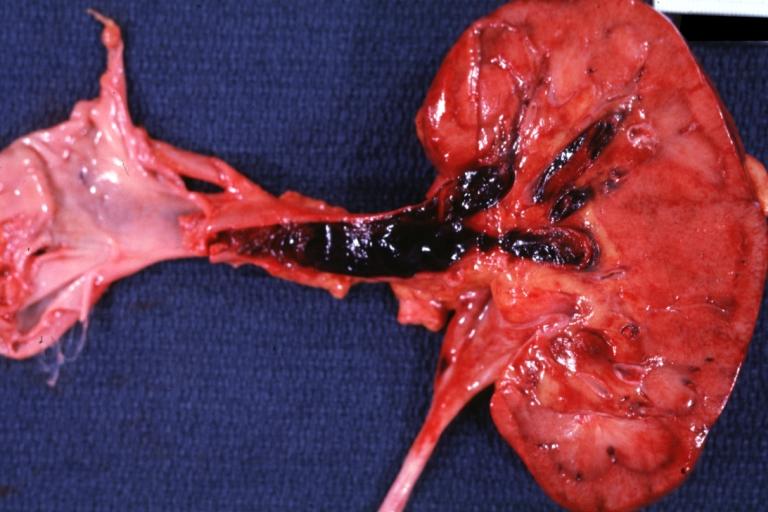Renal vein thrombosis: Difference between revisions
(→Causes) |
|||
| Line 81: | Line 81: | ||
===Imaging=== | ===Imaging=== | ||
* Renal venography: gold standard test for RVT diagnosis | |||
* Spiral computed tomography (CT) with contrast | |||
* Magnetic resonance imaging (MRI) | |||
* Doppler ultrasonography | |||
==Treatment== | ==Treatment== | ||
Revision as of 14:21, 30 May 2018
| Renal vein thrombosis | |
 | |
|---|---|
| Transplant with Renal Vein Thrombosis: Gross; natural color, opened kidney and vein. Image courtesy of Professor Peter Anderson DVM PhD and published with permission © PEIR, University of Alabama at Birmingham, Department of Pathology | |
| ICD-10 | I82.3 |
| ICD-9 | 453.3 |
| DiseasesDB | 11359 |
| MedlinePlus | 000513 |
For patient information page, click here
Editor-In-Chief: C. Michael Gibson, M.S., M.D. [1] Associate Editor(s)-in-Chief: Saeedeh Kowsarnia M.D.[2]
Overview
Renal vein thrombosis (RVT) is the formation of a clot or thrombus obstructing the renal vein.
Classification
Acute Chronic
Unilateral bilateral
Pathophysiology
A hypercoagulable state or mechanical compression of the renal vein is often present in those patients with renal vein thrombosis. This can be due to malignancy or it can be due to the nephrotic syndrome. In nephrotic syndrome there is an excessive urinary protein loss which is in turn associated with decreased antithrombin III. It is unclear why the renal vein is susceptible to thrombosis in patients with nephrotic syndrome.
Causes
Causes
- Malignancy
- Nephrotic syndrome
- Trauma (kidney biopsy)
- Oral contraceptive pills
- Hypovolemia
- Inherited coagulopathy
- Kidney transplant
- Antiphospholipid antibody syndrome
- Behçet's syndrome
Uncommon Causes
Epidemiology and Demographics
Malignancy especially renal cell carcinoma is the most common etiology consists of
Prevalence of renal vein thrombosis in nephrotic syndrome is 5 to 60% [3] .Membranous nephropathy is responsible for 20 to 60 % of the cases which makes it the most common cause of renal vain thrombosis among nephrotic syndromes. Other etiologies like minimal change disease, membranoproliferative glomerulonephritis, and focal segmental glomerulosclerosis cause 10 to 50 % of the cases.
Diagnosis
Symptoms
Back or flank pain may be present. Hematuria may be present.
Imaging
- Renal venography: gold standard test for RVT diagnosis
- Spiral computed tomography (CT) with contrast
- Magnetic resonance imaging (MRI)
- Doppler ultrasonography
Treatment
Surgery to remove the clot is possible, but rarely performed.
Anticoagulation therapy can have some benefits.[4]
Related Chapters
References
- ↑ Sailer, Christian, Wasner, Susanne. Differential Diagnosis Pocket. Hermosa Beach, CA: Borm Bruckmeir Publishing LLC, 2002:77 ISBN 1591032016
- ↑ Kahan, Scott, Smith, Ellen G. In A Page: Signs and Symptoms. Malden, Massachusetts: Blackwell Publishing, 2004:68 ISBN 140510368X
- ↑ Rajni Singhal & K. Scott Brimble (2006). "Thromboembolic complications in the nephrotic syndrome: pathophysiology and clinical management". Thrombosis research. 118 (3): 397–407. doi:10.1016/j.thromres.2005.03.030. PMID 15990160.
- ↑ Zigman A, Yazbeck S, Emil S, Nguyen L (2000). "Renal vein thrombosis: a 10-year review". J. Pediatr. Surg. 35 (11): 1540–2. doi:10.1053/jpsu.2000.18302. PMID 11083418.